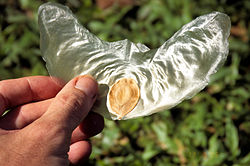| Alsomitra | |
|---|---|
 | |
| Alsomitra macrocarpa seed | |
| Scientific classification | |
| Kingdom: | Plantae |
| Clade: | Tracheophytes |
| Clade: | Angiosperms |
| Clade: | Eudicots |
| Clade: | Rosids |
| Order: | Cucurbitales |
| Family: | Cucurbitaceae |
| Tribe: | Gomphogyneae |
| Genus: | Alsomitra L. |
| Species | |
See text | |
| Synonyms | |
Alsomitra is a genus of the plant family Cucurbitaceae (the cucumber, squash, and pumpkin family).
Contents
The seeds of Alsomitra macrocarpa are among the largest winged seeds in the plant kingdom and their shape inspired a number of aviation pioneers. [2] [3]